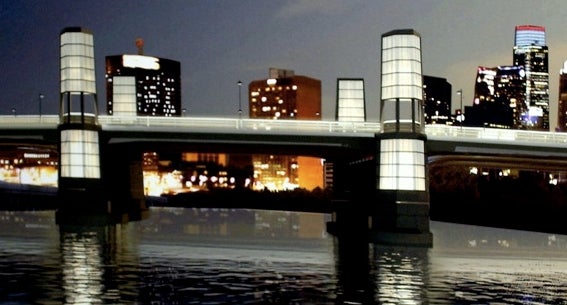South Street Bridge OK’d, with reservations

Sept. 3
By Thomas J. Walsh
For PlanPhilly
(Previous coverage: Aug. 18, 2009.)
Despite objections that the newly designed surface and lighting plans for the South Street Bridge lack a certain amount of imagination and ignore sustainability measures to the point that it is “absolutely unacceptable,” the Philadelphia Art Commission voted Wednesday morning to approve a design for the span that was OK’d last month by Mayor Michael Nutter.
James Templeton, the designer at H2L2 Architects who led the efforts behind three options for the new look for the bridge, told the Art Commission some of the back story about what has happened over the past three years that led to this moment. He outlined the decrease in driving lanes from five to four, and clearly defined bicycle lanes, painted green, and wider than many at six feet, four inches.
He said the light towers – lanterns that are hoisted up on satin-style stainless steel and extend below the road level of the bridge – create a pedestrian outlook space between that measures 11 feet, four inches.
Commissioner Karen Davis expressed surprise that the new design retained so much of the industrial look that had previously been criticized. She said she felt that it was “not particularly creative.”
But Commissioner Emanuel Kelly, an architect who also sits on the Zoning Code Commission, said the team was to be commended, given the constraints of time, size and budget placed upon them. He said the newly designed towers and the intense community involvement made it a “very successful” effort.
Moe Brooker, chairman of the Art Commission, agreed. “To my eyes I think that you use industrial materials, but you end up with a very classic looking lantern,” he said. “I think it’s a handsome bridge.”
“What I object to,” said Commissioner Sean Buffington, is that “choices made at the outset” of the entire process, years ago, “were choices not to imagine this as a real opportunity.
“You ended up in a place that’s acceptable, and the community has embraced it, and [it came through] what was a very difficult situation,” Buffington said. “We’ve had this discussion about bridges before. There is extraordinary work being done on bridges everywhere in the world.
“Cities are using bridges as a means of distinguishing themselves, he added, “and we’re not doing that. … I understand that the cow is out of the barn, this is gonna happen, but I at least wanted this buried somewhere in the archives.”
“Sean’s point is well taken,” Brooker said, adding that the process informing the design of the South Street Bridge has set a precedent in more ways than one – things to consider in the future, and the fact that it “does make a statement. I think it does distinguish itself from other bridges.”
Four community-based principles guided design for the bridge, Templeton explained: A continuity of line for the lanterns below and above the deck; the idea that it constitutes a “civic presence” and a gateway between two neighborhoods, as well as an entrance via automobile and boat; a desire to preserve the pedestrian overlook areas; and a desire that the design “be very open” for safety and visibility.
The thousands of pin LED lights that will illuminate the lanterns are capable of millions of colors, the commissioners were told, as a rudimentary model of the lights was demonstrated. Laminated, impact-resistant safety glass will protect the lights between stainless steel mullions that will have a striped effect.
In addition, lights will be included within a stainless steel crash rail that will be seen from below the bridge, along the river. They will be consistently white.
‘Wasted space’ and a ‘wasted opportunity’
Probably the sternest critic was Commissioner José Almiñana, a landscape architect and a principal at Andropogon Associates. “I find it surprising,” Almiñana said, that within a $52 million budget, there was not more room for more efforts toward sustainability.
“We’re all paying for this in the long-term,” he said. “And I cannot accept” excuses when grants from the federal government and state are to be had. “It is just absolutely unacceptable and I think that it is time for every project” that comes through the Art Commission adheres to and support the mission of sustainability.
“I don’t see the need for having sidewalks that are 12- or 14-feet wide,” he added, after saying he was happy the bike lanes were wider than they needed to be (though he’d prefer them to be even wider, to 8 feet). Declining to elaborate on his opinion of the roadway itself, he did add, “I see a lot of wasted space there.”
“I am disappointed that this is a significant wasted opportunity,” Almiñana said.
Present for the hearing was Jack Lutz, chief bridge engineer, Dave Perri, chief of surveys and design for the Streets Department, and various neighborhood representatives and ward leaders.
Also observing was Planning Commission Executive Director Alan Greenberger, one of the three deputy mayors to weigh in with Nutter on choosing what was “Option 3” of three designs presented to the public by H2L2 over the summer. Also voting were Rina Cutler, head of the Transportation Department, and Clarena Tolson of the Department of Streets.
Contact the reporter at www.ThomasJWalsh.info.
WHYY is your source for fact-based, in-depth journalism and information. As a nonprofit organization, we rely on financial support from readers like you. Please give today.



